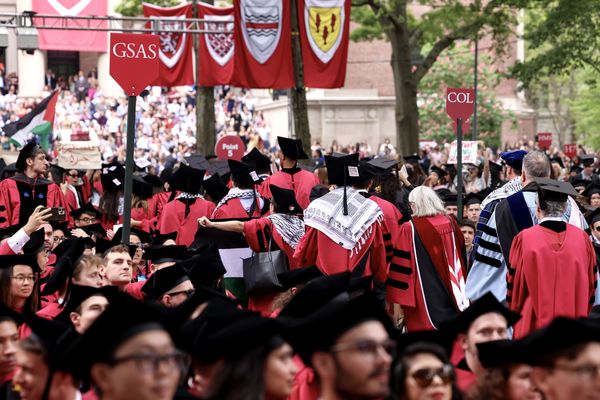Severance, which imagines a world where a person’s work and personal lives are surgically separated, will soon return to Apple TV+ for a second season. While the concept of this gripping piece of science fiction is far-fetched, it touches on some interesting neuroscience. Can a person’s mind really be surgically split in two?
Remarkably, “split-brain” patients have existed since the 1940s. To control epilepsy symptoms, these patients underwent a surgery to separate the left and right hemispheres. Similar surgeries still happen today.
Later research on this type of surgery showed that the separated hemispheres of split-brain patients could process information independently. This raises the uncomfortable possibility that the procedure creates two separate minds living in one brain.
In season one of Severance, Helly R (Britt Lower) experienced a conflict between her “innie” (the side of her mind that remembered her work life) and her “outie” (the side outside of work). Similarly, there is evidence of a conflict between the two hemispheres of real split-brain patients.
When speaking with split-brain patients, you are usually communicating with the left hemisphere of the brain, which controls speech. However, some patients can communicate from their right hemisphere by writing, for example, or arranging Scrabble letters.
A young patient was asked what job he would like in the future. His left hemisphere chose an office job making technical drawings. His right hemisphere, however, arranged letters to spell “automobile racer”.
Split brain patients have also reported “alien hand syndrome”, where one of their hands is perceived to be moving of its own volition. These observations suggest that two separate conscious “people” may coexist in one brain and may have conflicting goals.
In Severance, however, both the innie and the outie have access to speech. This is one indicator that the fictional “severance procedure” must involve a more complex separation of the brain’s networks.
Looking for something good? Cut through the noise with a carefully curated selection of the latest releases, live events and exhibitions, straight to your inbox every fortnight, on Fridays. Sign up here.
An example of a complex separation of function was described in the case report of Neil, in 1994. Neil was a teenage boy who had a number of difficulties following a pineal gland tumour. One of these difficulties was a rare form of amnesia. It meant that Neil could not recall the events of his day or report what he had learned in school. He had also become unable to read, although he could write, and was unable to name objects, although he could draw them.
Astonishingly, Neil was able to keep up with his education. Researchers became interested in how he was able to complete his schoolwork despite having no memory for what he was learning.
They quizzed him about a novel he was studying at school, Cider with Rosie by Laurie Lee. In conversation, Neil could not remember anything about the book – not even the title. But when the researcher asked Neil to write down everything he could remember about the book, he wrote “Bloodshot Geranium windows Cider with Rosie Dranium smell of damp peppar [sic] and mushroom growth” – all words connected to the novel. As Neil could not read, he had to ask the researcher: “What did I write?”
Neil was also able to write down other memories that were thought to be lost, including meeting a man with gangrene in hospital. In each case, he was unaware of his own memory until he wrote it down and had it read back to him. Neil’s case is a staggering example. It suggests that it is possible to have rich memories that are inaccessible to our consciousness.
In Severance, Irving’s (John Turturro) outie can access memories of his innie’s work environment through painting. He paints the long hallways of the Severed floor (where his innie works), despite having no conscious memory of them. Perhaps then, in the show, the severance procedure involves blocking conscious access to memory in the same way that this access was blocked in Neil.
The role of the hippocampus
Which brain regions might be core to the TV show’s severance procedure? The region most associated with remembering the events of the work day is the hippocampus – and, interestingly, this same brain region also supports the representation of space.
The fact that the same neural structure supports both remembering that a new colleague has joined your team today, and representing the layout of the office, suggests that the hippocampus might be a good target for this fictional procedure.
In Severance, the switch between innie and outie occurs at the boundary to the office – the elevator doors. This is reminiscent of “the doorway effect”, the phenomenon in which walking through a doorway makes you forget something.
The hippocampus segments our experience into episodes for later recall. Entering a new space is an indicator that a new episode has started, which leads to increased forgetting of information that spans these episodes. The effect is subtle, however. Although you might sometimes walk into the kitchen and forget why you went in, you don’t forget that you have children – unlike the dramatic effect caused by the show’s severance procedure.
Perhaps, in the show, the hippocampus’ interest in spatial boundaries triggers the switch between innie and outie.
Unfortunately, there are two crucial flaws with the idea that the show’s severance procedure could involve a simple snip to the hippocampus.
First, it’s not just episodic and spatial memory that is divided in Severance. The workers have a great deal of semantic knowledge (facts about Lumon, the company they work for, and its founder, for example) that is inaccessible to their outies. They also form emotional memories linked to the rewards they get for hard work and the punishments that they receive in the break room. These forms of memory rely on far more than the hippocampus, and the hippocampus itself is part of a brain-wide episodic memory network that is activated during episodic memory retrieval.
The second flaw is that memory itself is not an isolated process. It is closely connected to perception, attention, language and many other processes. The human memory system is far too complex to be entirely split in two – but as Severance shows, it’s fun to think about the possibilities.
The authors do not work for, consult, own shares in or receive funding from any company or organisation that would benefit from this article, and have disclosed no relevant affiliations beyond their academic appointment.
This article was originally published on The Conversation. Read the original article.







